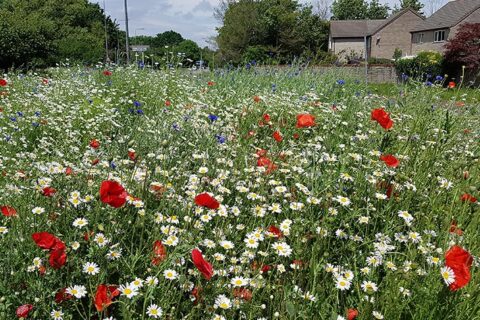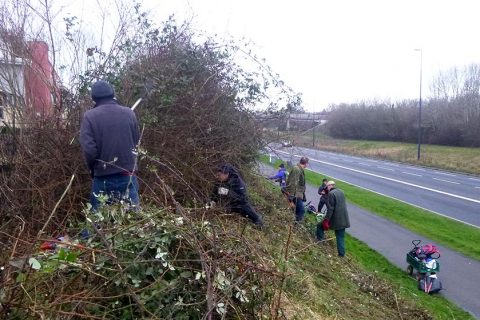An update from Sara Messenger of Bradley Stoke’s Three Brooks Nature Conservation Group.
We’ve had a very busy last couple of months but we have at last seen our Savages Wood paths project completed. The contractors that completed the work are called Greenfields and we think it all went well, although I’m not sure their lads would all agree. It wasn’t all plain sailing – a new ramp was added at the last minute, a lorry broke all our paving slabs and there was quite a bit of head scratching over how to install the new disabled access gate (a big thank you to the Disabled Ramblers group for all their help). I think Jack felt he’d dug more holes than an entire family of moles, as both gate posts were moved several times and then the main gate was vandalised, requiring them to return and replace the posts yet again. However, I think we are all in agreement that it’s been worth the effort as now not only can wheelchairs access the woods but also those with pushchairs and those not quite so steady on their feet, as well as our usual dog walkers, runners and cyclists both young and slightly older.
Our new slowworm refugia have also proved to be an asset. Last year a few hundred of the reptiles were translocated from a building site onto the reserve and we agreed to survey the population to see if it was successful. Refugia have been put in place around the reserve to monitor the slowworm population, we’re very pleased to see that it appears to be thriving and in areas that we weren’t previously aware we had slowworms. They are a protected species, so if you find a refugia please don’t disturb it as slowworms can, when they feel threatened, shed their tails. A slowworm is a legless lizard not a snake, the most obvious difference is that they, unlike snakes, have eyelids and flat black tongues. They will be fully grown after 6 to 8 years although the females can breed from 4 to 5 years and I’m told they can grow up to 50cm, although I have yet to see one of ours half that size.
Balsam bashing
Despite South Gloucestershire Council, back in February, imposing a blanket ban on either group working in or near water, we do seem to have won the battle of the balsam this year. Although quite an attractive plant, Himalayan balsam is very invasive and no good for wildlife, so a fair part of the year is spent clearing it from the reserve. Although it can grow to 10ft, it has a small root ball so is easily pulled up by even the youngest helper and I’m very fond of telling them that if you stamp on it, it sounds like dead men’s bones! Each year we have less and less balsam and that’s purely down to the hard work of our dog walkers pulling their ‘ten a day’ and to our volunteers both on workdays and on odd free evenings when they can be spotted prowling through the undergrowth. I genuinely think they get more excited at finding a balsam stalk than they do at finding a £5 note.
Working on water
In July, eight members of the group gave up another day to attend a weekday training session on ‘working on water’. On this quite contentious issue, we’ve seen, to borrow a phrase, “more U-turns than you’d see on a box set of Top Gear DVDs”. However, we are hoping that we have now finally reached an agreement and can get back to doing what we need to do to retain our licences and to look after the reserve.
Organised walks
Our bats walks have again proved popular and this year our three walks were run by Avon Bat Group member Laura Mulholland. We mostly detected common pipistrelle but also encountered a few Daubenton’s and noctule bats, although we have yet to locate the new noctule roost. If you’ve missed our walks, you can always borrow for free one of our bat detectors that we have at Bradley Stoke library. Just don’t forget to tell us if you find anything interesting!
After a slight delay, our nature walk with professional ecologist Rupert Higgins got off to a good start and we had lots of very inquisitive children who asked some great questions, although I think they only managed to stump Rupert once!
We also had a hugely popular foraging walk with Bristol’s wildlife ambassador Steve England. We’ve had foraging walks before, but Steve’s ‘cook out’ at the end made this one stand out and we are very much looking forward to his next walk with us in October.
All our walks, events and workdays are free to the public. This is only made possible by our service level agreement with Bradley Stoke Town Council and the conservation group gratefully acknowledges their support.
• How to contact the Three Brooks Nature Conservation Group…
t: 07497 006676
e: info@three-brooks.info
w: www.three-brooks.info
Facebook: Three Brooks Nature Conservation Group
Photos: 1 A good turnout for the foraging walk with Steve England. 2 In Bowsland Meadow on the nature walk. 3 Enjoying the fruits of the foraging walk at the ‘cook out’.
This article originally appeared in the October 2019 issue of the Bradley Stoke Journal magazine (on pages 32 & 33). The magazine is delivered FREE, EVERY MONTH (except August), to ALL 8,700 homes in Bradley Stoke. Phone 01454 300 400 to enquire about advertising or leaflet insertion.






